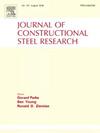Numerical analysis on structural behavior of headed stud-steel block connectors (HSBCs)-UHPC grouting
IF 4
2区 工程技术
Q1 CONSTRUCTION & BUILDING TECHNOLOGY
引用次数: 0
Abstract
To investigate the structural behavior of the headed stud-steel block connectors (HSBCs)-UHPC grouting in prefabricated steel-concrete composite beams, a refined finite element (FE) model is established to simulate the push-out test of HSBC. This FE model can effectively simulate the push-out test, including the shear force-slip curve and failure mode. Typical failure characteristics of two failure modes (shear failure and concrete compression failure) are discussed in detail on the verified FE model. Then, the effects of the change in the steel block height (steel block height-to-slab thickness ratio), concrete strength, stud diameter, shear pocket spacing, concrete slab width, and steel block length are elucidated through parametric studies. Based on the typical failure characteristics of failure modes and the parameter analysis results, theoretical analysis models for the two failure modes are established, and the corresponding calculation formulas are proposed. The influence of each parameter is evaluated by fitting with the FE analysis results. These theoretical formulas can effectively predict the shear capacity and the failure mode of HSBC by comparing them with the FE analysis results, with good agreement. Additionally, a three-stage linear shear force-slip curve is proposed, and the predicted results are basically close to the experimental results.
求助全文
约1分钟内获得全文
求助全文
来源期刊

Journal of Constructional Steel Research
工程技术-工程:土木
CiteScore
7.90
自引率
19.50%
发文量
550
审稿时长
46 days
期刊介绍:
The Journal of Constructional Steel Research provides an international forum for the presentation and discussion of the latest developments in structural steel research and their applications. It is aimed not only at researchers but also at those likely to be most affected by research results, i.e. designers and fabricators. Original papers of a high standard dealing with all aspects of steel research including theoretical and experimental research on elements, assemblages, connection and material properties are considered for publication.
 求助内容:
求助内容: 应助结果提醒方式:
应助结果提醒方式:


